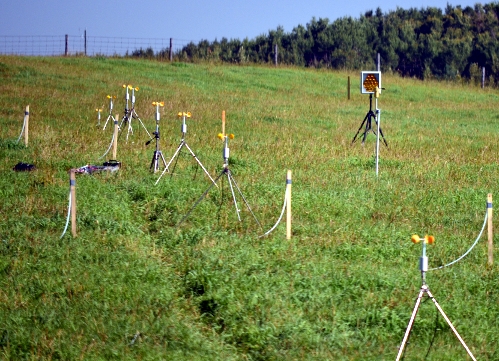 Back to John D. Wilson home page.
Back to John D. Wilson home page.
Here 20 heifers are confined (temporarily) in a pen (of dimension 5 m by about 120 m) by an electric fence, at a research station at the Agriculture and Agrifood Canada (AAFC) research station at Lacombe (Alberta). Line-averaging laser gas sensors measure the differences in the methane and ammonia concentrations upwind and downwind from the pen. A computer model of short range gas transport (WindTrax) is used to infer the rate of emission of these gases.
One of the lasers can be seen at the right of the telephoto image above. Infrared light travels to a reflector (one of several seen in the distance, at the other end of the enclosure) and back to the receiver in the foreground. A sonic anemometer (not seen in the image) determines the wind conditions.
Another team of scientists measured animal feed intake and feed quality. The heifers grazed a new pen each day.
Prior to the cattle measurements, the technique was tested by artificially releasing methane from 8 point sources spread over an area of 5 m x 120 m (tubing can be seen running to the release points in the image below). Again, a sonic anemometer determined wind statistics. Twelve cup anemometers, arrayed at equal distance above ground over the slightly undulating surface, measured the spatial variability of the wind as a function of the wind direction.
 Back to John D. Wilson home page.
Back to John D. Wilson home page.
Back to the Earth & Atmospheric Sciences home page.